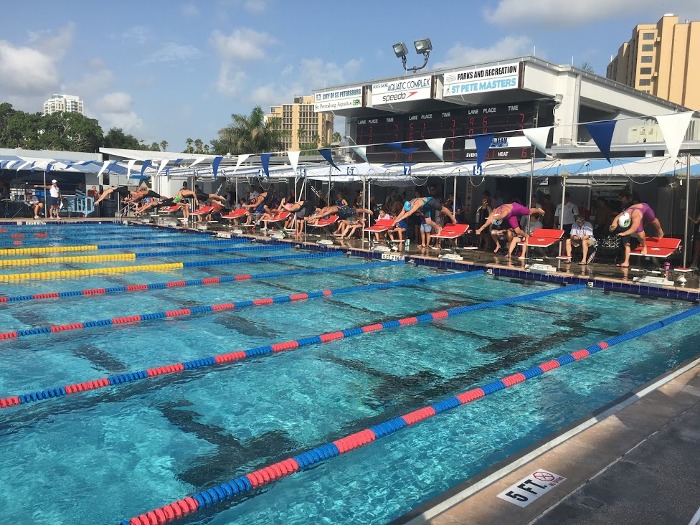A Guide to Swim Meet Survival

Swim Meets 101
A Guide to Swim Meet Survival
We hope that this guide will give you a general idea of what to expect. Once you get through your first meet, everything will make so much more sense!
No two swim meets ever run exactly the same. It can be the same meet that the club hosts each year, but things will be different. The most important thing to remember is to be flexible. Swim meets are large undertakings and are run by humans who are fallible.
It’s ok to be a little confused at first. Don’t be afraid to approach someone from our team to ask a question. We have the best swim parents who are more than willing to help out a new family!
Chapter 1 – The Night Before
The Swim Bag
In addition to the routine stuff to bring to practice (swimsuit, towel, goggles and cap), you will want need a few more things for a swim meet. Here’s a basic checklist:
- Extra-large towel or blanket for your swimmer to keep warm between races or sit on if necessary
- Towels…two are better than one
- Loose fitting, comfortable clothing to wear in between races
- Chairs and/or a tent (commonly called an easy up) if it is an outside meet
The “Other” Bag
Do NOT underestimate the importance of “The Other Bag”. This is the activity bag to keep your children happy and busy while they wait for their events to be called. Rest is important particularly at the long invitational meets; here are some suggestions for quiet, yet fun activities:
- Electronic hand held games
- Cards, Travel Games
- Books
- Portable Phone, iPad
Remember to label all your items and keep an eye on your things! You are out in public and at a large event where there are many people who are not always playing close attention. Theft can happen anywhere.
What Parents Need
While some people enjoy watching the competitors and spend nearly all of their time in the pool area, other people prefer to relax with their children in between events. You may want to consider bringing some of the following:
- A comfortable folding chair (bleacher seats [if available] will get uncomfortable as the day progresses)
- Ball-point pen, magic marker, highlighter
- Book, paper, magazine
- If this is a home meet that we are hosting, you will likely be busy helping with one of the many volunteer positions and won’t need to bring these kinds of items.
If you are at an indoor meet and dressed for cold weather, it gets VERY warm in the indoor pool area. Be sure to dress in layers or bring some lightweight clothing to change into.
The Cooler
If you opt to pack food/drinks, here are some good and bad swim meet food choices:
Good:
- Water, juice, sports drink (fluids are VERY important) NO SODA
- Bagels (hold the cream cheese)
- Carrot and celery sticks
- Fruit – grapes, bananas & apples (oranges can be messy)
- Granola bars, oatmeal
- Plain or artificially sweetened yogurt
Think natural energy. Easily digestible, portable foods are your best choices.
Bad:
- Candy & sweets (anything with heavy sugar content)
- Fatty foods (takes too long to digest)
- Greasy, heavy foods (no nutritional value)
FLUIDS ARE VERY IMPORTANT! Even slight dehydration can cause cramping and fatigue and a bad swim meet experience. Encourage your swimmer to hydrate all day long. Moderate your child’s food intake and remember less is better. Some kids think they’re hungry when really they’re bored and looking for something to do (visit “The Other Bag”).
Now that you’re all packed…tuck the kids in bed. Swimmers need a good night’s sleep. Most meets start early! Make sure you know the warm-up times and have planned to arrive at least 15 minutes prior. Check to be sure you have printed out the directions to any away meets.
Chapter 2 – The Arrival
What do I do FIRST?
When you first arrive, have your children go to the designated locker area and change into their swimsuit. They should take their cap, goggles and towel and immediately report to their coach in the pool area. Pick out your “camping” spot. If outdoors, set up your tent and chairs. If in a gym, set up your chairs and put out your blanket so your swimmer has a place to hang out while waiting for their next race.
Heat Sheet
Some meets you can download the heat sheet from the internet, others you can purchase your heat sheet. While your swimmer is warming up, this is the time to get out your highlighter and mark your swimmer’s events. Once your swimmer returns, make sure they drink something and wrap up in either a blanket or parka if it is cold. They should just hang out and rest for their first race! It is also a good time to make sure they know their events. A very convenient place to write them down is on the back of your child’s hand or arm.
Remember to use a waterproof marker or pen. Sharpies are perfect! You will see most of the 10 and under kids with this. Here is an example:
The first number represents the event number, the second the heat number and the third the lane number and finally the distance and stroke abbreviation.
10/3/5 – 25 fr = Event 10, Heat 3, Lane 5 in the 25 free event
16/2/4 – 50 bk = Event 16, Heat 2, Lane 4 in the 50 back
Don’t worry too much; your child will get a helpful reminder at Clerk of Course and also on deck before they jump in the water. The important thing is that your child remains either on the pool deck or in the gym where they can hear the clerk of course workers call the event numbers.
They will not wait on a swimmer who is not on the block when it is their time.
Chapter 3 – The Meet
If this is a meet we are hosting, head to your volunteer post. Just keep an eye on your child’s event numbers so you have plenty of time to watch their swim. Don’t worry, your volunteer coworkers all have the same idea – we work together to make sure we don’t miss our children’s events.
If we’re at another team’s hosted meet, this is a great time to scope out their facility a bit. Make sure you know where the clerk of course is, the restrooms and of course the pool area, and finally how to get back to your camp.
Make sure that your swimmer stays warm and hydrated. The body uses energy to warm itself and energy is something to conserve before events. Make sure that they keep up with their cap and goggles – there’s nothing more nerve wracking than searching for caps and goggles seconds before its time to report. If they keep their caps on and goggles pulled down like a necklace, they’re less likely to lose them.
Your main job at this point is to make sure your child stays nearby between events as opposed to wandering the facility.
Clerk of Course
Clerk of Course is a staging area where children are gathered and put in an orderly fashion to enter the pool area. This is critical to making certain kids are lined up for the right heat and the right event. Clerk of Course is staffed by parent volunteers from the host team. The staging area might be on the pool deck or in the gym. It will consist of several rows of chairs and very hard working parents calling out swimmer names and lane assignments over and over again.
Clerk of Course workers will continually announce the next event. When your child hears FIRST CALL for an event number…they should check their arm to see if they are swimming this event. This is a skill they should be taught early in their swimming career. If your child is not paying attention to the calls, they could miss an event and will be extremely disappointed. When your child’s event is called, they should head to Clerk of Course and listen for their name. They will be shown to a seat that marks their order. Once a child is seated in Clerk of Course, they should remain there until they are escorted into the pool area.
Okay, I know what Clerk of Course is; my child is sitting in there now, where do I go? Head for the pool to finally see what you came for – YOUR swimmer in the water!
People are constantly moving in and out of the pool area and you will notice there is a lot of activity going on. Resist the temptation to go see your child. After the race, your swimmer will head back to your spot where you can meet them and give them their much-deserved kudos!
Remember that as a parent you are not allowed behind the blocks, to discuss time with the timers, or approach the stroke and turn judges. If there is a question or problem, you should ask your coach who will then handle it for you.
Note: It is very important that your child speaks to their coach both before and after their race. This is a great way to get immediate feedback during a race setting.
Swimmer Disqualifications
It takes time and lots of practice to master the technical aspects of competitive swimming. Throughout your child’s swimming career, they will increase their knowledge and improve their starts, strokes, turns and finishes. During a sanctioned meet, officials and judges monitor the competition to ensure that starts, strokes, turns and finishes are done in accordance with rule requirement. Some latitude is granted to younger swimmers, but it is important that proper stroke technique be learned early in a swimmer’s career.
ALL kids will at some time in their career, experience the disappointment of being disqualified (DQ’d) in an event. Remember that this is a learning opportunity and the DQ is an excellent tool to help your child. Though it may be disappointing, you can help your child by offering support and encouraging them to always do their best. After the meet the team receives the DQ slips and you may email a request to find out the specific error committed.
Race Results
Head back to your spot and get ready for your next event. After a couple of events, you can go looking for where the computer operators are posting the results. The results usually run a few events behind due to processing time. This is where you will find out what your swimmer’s time was and how they fared among all the swimmers in their age group. The results are listed by event and show the swimmers in order of finish.
Ribbons and trophies are awarded for most meets. Ribbons are usually given for 1st through 6th place finishes in each event. Trophies are usually awarded for High point winners and runner ups. High point winner are the swimmers who scored the most points in their age group during the meet.
Ribbons are distributed at practice, usually a couple of days following the meet. Trophies for High Point and Runner Up are awarded after the meet.




